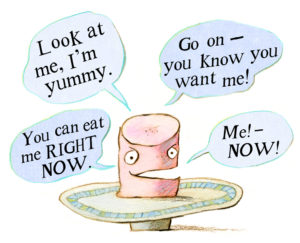If I told you that if you reduced your nonprofits services by 10% this coming year, you could be back to where you are the next year along with a 20% improvement that would carry on in future years, would you make the reduction?
I hope that you would say “yes” – the math works.
But if I said you had a “chance” to get the 20% improvement – not a guarantee – then it becomes tricky. And that is the problem that a lot of organizations – for profit and nonprofit – have with innovation. They are unwilling to take the chance that investing money and time in innovation will pay off in the future. It is a short term focus. And it is not unlike the problem of instant gratification.
 You have probably heard about the Stanford Marshmallow Study in the 1970s. Children – four and five year-olds – were given a marshmallow and told that if they would wait to eat it until the adult comes back into the room in fifteen minutes they would be given a second marshmallow. But if they eat it before the adult comes back, that’s all they get. (Click here for fun video example.) When these children were tracked through their adult years, the ones who exercised delayed gratification had much higher quality of life in a wide variety of measures. Having the self-control to focus on the future and delay gratification paid off in a big way for these children.
You have probably heard about the Stanford Marshmallow Study in the 1970s. Children – four and five year-olds – were given a marshmallow and told that if they would wait to eat it until the adult comes back into the room in fifteen minutes they would be given a second marshmallow. But if they eat it before the adult comes back, that’s all they get. (Click here for fun video example.) When these children were tracked through their adult years, the ones who exercised delayed gratification had much higher quality of life in a wide variety of measures. Having the self-control to focus on the future and delay gratification paid off in a big way for these children.
Can we learn delayed gratification from these children and forgo some of today’s services for the hope of more in the future?
It is admittedly challenging. Most nonprofits are dealing with real people who have real challenges right now. But it is likely that you will continue to have people with these needs into the future – probably more than you can serve. Therefore, investing in the future makes sense if we want a long term Mission Impact.